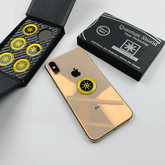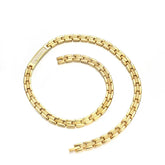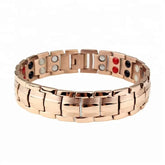Is Radiation from Apple Watch a Real Concern?
Apple Watches have become a part of everyday life, tracking workouts, sleep, and even heart rate. But as these devices stay on our wrists all day (and sometimes all night), many people have started asking an important question: does the Apple Watch emit radiation, and is it safe to wear daily?
Like most smart devices, the Apple Watch uses Bluetooth and Wi-Fi signals to stay connected. These signals give off low levels of electromagnetic fields (EMF), the same type of radiation emitted by smartphones, laptops, and wireless routers. and if you're new to the topic, you can learn more about what EMF radiation is here.
The concern isn’t new. As wearable tech becomes more common, users wonder whether constant EMF exposure from devices like the Apple Watch can affect health. Some Reddit threads and Apple Community discussions even question if it’s okay to sleep while wearing one.
In this article, we’ll take a closer look at radiation from Apple Watch, what kind of EMF it emits, how much it produces, and whether these levels fall within global safety limits. The goal isn’t to create fear, it’s to share clear, science-backed facts so you can decide how to use your Apple Watch safely and confidently.
What Kind of Radiation Does an Apple Watch Emit?
The Apple Watch, like most wireless devices, emits non-ionizing electromagnetic fields (EMF). In simple terms, that means the radiation it gives off is low-frequency and low-energy, the same kind produced by Wi-Fi routers, Bluetooth headphones, and smartphones.
This type of radiation is completely different from ionizing radiation, which is the high-energy kind found in X-rays or ultraviolet rays. Ionizing radiation can damage DNA and cells if exposure is intense or prolonged, but the non-ionizing radiation from an Apple Watch can’t do that.
Every time your Apple Watch connects to your iPhone, syncs data via Bluetooth, or uses Wi-Fi or LTE, it emits a small amount of radiofrequency (RF) energy. These signals help it communicate wirelessly, for example, when sending notifications or tracking your fitness in real time.
To put it in perspective, the EMF from an Apple Watch is similar to what you’d get from a short Bluetooth call or being near a Wi-Fi router for a few minutes. The energy is low, short-range, and far below the limits set by global safety standards.
So, while the phrase “radiation from Apple Watch” might sound alarming, it’s important to understand the science: the device emits non-ionizing radiation, which is considered safe and comparable to what you’re already exposed to daily from other household electronics.
Does the Apple Watch Give Off EMF or Something Else?
Yes, the Apple Watch gives off EMF, specifically low-level, non-ionizing electromagnetic fields. This type of radiation from Apple Watch is the same safe kind produced by Bluetooth, Wi-Fi, and LTE signals. Unlike ionizing radiation (X-rays), Apple Watch EMF is low energy, non-harmful, and within FCC and WHO safety standards.
What’s the Difference Between Ionizing and Non-Ionizing Radiation?
To understand why radiation from an Apple Watch isn’t dangerous, it helps to know the difference between ionizing and non-ionizing radiation, two very different forms of energy.
- Ionizing radiation has high energy, strong enough to remove tightly bound electrons from atoms. This type includes X-rays, gamma rays, and some ultraviolet (UV) rays. Because it can alter cell structures or DNA, it’s the kind used in medical imaging or found in nuclear sources and yes, that’s the type that can be harmful with prolonged exposure.
- Non-ionizing radiation, on the other hand, has low energy. It can’t change atomic structures or damage cells. This is the type produced by everyday devices like Wi-Fi routers, Bluetooth headphones, and the Apple Watch.
In short:
- Ionizing = high energy, potentially harmful (X-rays, UV).
- Non-ionizing = low energy, safe for daily use (Wi-Fi, Bluetooth, Apple Watch).
The Apple Watch uses non-ionizing radiation, meaning it operates on the same safe frequency range as your phone or home Wi-Fi. It’s designed to stay well within global safety standards set by organizations like the FCC and WHO, making it safe to wear throughout the day.
Which Apple Watch Features Use EMF: Bluetooth, Wi-Fi, or LTE?
The Apple Watch emits EMF when it uses Bluetooth, Wi-Fi, or LTE to connect and transmit data. These wireless features are what make the watch “smart”, allowing it to sync with your iPhone, access the internet, or make calls without needing your phone nearby.
Here’s how each connection type works:
|
Feature |
How It Works |
Type of Radiation |
EMF Level / Safety Info |
|
Bluetooth |
Connects the Apple Watch to your iPhone for syncing apps, tracking workouts, and receiving notifications. |
Non-ionizing EMF |
Emits very low-level radiation, significantly lower than a smartphone’s Wi-Fi signal. |
|
Wi-Fi |
Connects to known Wi-Fi networks when the iPhone isn’t nearby; enables background updates and cloud syncing. |
Non-ionizing EMF |
Similar to EMF from laptops or tablets; safe and low power output. |
|
LTE (Cellular Models) |
Allows calls, texts, and data use without an iPhone by connecting to cellular networks. |
Non-ionizing EMF (radiofrequency) |
Slightly higher than Bluetooth/Wi-Fi but remains well below FCC and WHO safety limits. |
How Much Radiation Comes from an Apple Watch?

The Apple Watch emits very low levels of EMF radiation, with a Specific Absorption Rate (SAR) ranging between 0.07 and 0.5 W/kg, depending on the model. That’s far below the official safety limits set by global authorities like the FCC (1.6 W/kg) in the U.S. and ICNIRP (2.0 W/kg) in the EU.
The SAR value measures how much radiofrequency (RF) energy your body absorbs when exposed to an emitting device. In simple terms, it tells you how much EMF the Apple Watch emits during use. The lower the SAR value, the less energy your body absorb, and Apple’s numbers are comfortably within international safety guidelines.
To put it into perspective, the radiation from Apple Watch is far lower than what comes from a smartphone, which typically measures between 0.9 and 1.5 W/kg. That’s because your watch uses short-range Bluetooth and low-power Wi-Fi signals, not the high-power cellular transmission of phones.
Even the LTE (cellular) Apple Watch models, which use more power than non-cellular versions, still emit only a fraction of the radiation that smartphones do. All Apple Watches undergo strict FCC and ICNIRP testing to ensure EMF exposure stays within safe limits during normal use.
So, if you’re wondering about Apple Watch radiation data, here’s the simple takeaway: The levels are very low, well within international safety limits, and significantly lower than phones or tablets.
That means you can wear your Apple Watch daily, for fitness, communication, or sleep tracking, without exceeding any recognized EMF safety thresholds.
What is the SAR value of the Apple Watch?
The SAR value of the Apple Watch ranges from 0.07 to 0.5 W/kg, depending on the model. SAR (Specific Absorption Rate) measures how much RF energy the body absorbs from EMF exposure. Each Apple Watch model is individually tested and certified by the FCC to ensure compliance with global radiation safety limits.
How does Apple Watch radiation compare to a smartphone?
The Apple Watch emits 10–20 times less EMF radiation than a smartphone. Phones use high-power cellular transmitters that operate over long distances, while the watch primarily uses Bluetooth and Wi-Fi. As a result, Apple Watch radiation levels are significantly lower, staying well within FCC and ICNIRP safety standards for daily exposure.
What are the FCC and WHO safety limits for EMF exposure?
The FCC limits EMF exposure to 1.6 W/kg, while ICNIRP and WHO recommend a global standard of 2.0 W/kg. The Apple Watch’s SAR values (0.07–0.5 W/kg) are far below these limits. Both the FCC and WHO confirm that Apple Watch EMF levels are safe for continuous, everyday wear and use.
Is the Radiation from Apple Watch Harmful to Health?
Current scientific evidence shows no proven health risks from Apple Watch radiation. The device emits non-ionizing EMF, which lacks the energy to damage DNA or cells. According to the World Health Organization (WHO) and FCC, Apple Watch radiation levels are well within safe exposure limits for daily wear.
While some users report headaches or sleep issues around EMF, research hasn’t confirmed a direct link. Studies on wearable radiation and EMF exposure continue, but as of now, the Apple Watch is considered safe and poses no measurable health risks under normal usage conditions.
What do scientific studies say about EMF from wearables?
Peer-reviewed studies and organizations like the World Health Organization (WHO) and ICNIRP report no confirmed health risks from non-ionizing EMF emitted by wearables such as the Apple Watch. Current scientific evidence shows that Apple Watch radiation levels are too low to cause biological harm, remaining well within FCC-approved safety limits.
Can long-term exposure cause side effects or sleep problems?
There is no clinical evidence linking Apple Watch EMF exposure to health issues like sleep problems, headaches, or fatigue. However, some individuals report mild discomfort anecdotally. Scientific studies suggest these effects are likely psychological rather than physical, as non-ionizing EMF from wearables operates far below harmful radiation thresholds set by health agencies.
What is Apple’s statement or testing policy on radiation safety?
Apple Inc. states that every Apple Watch model undergoes FCC-certified SAR testing and meets or exceeds global EMF safety standards. Apple’s documentation confirms the Apple Watch radiation output stays far below the 1.6 W/kg SAR limit. This ensures all devices comply with WHO and ICNIRP recommendations for safe, daily wear.
Can I Reduce My EMF Exposure from Apple Watch?
Yes, you can reduce EMF exposure from your Apple Watch without sacrificing its main features. While the Apple Watch emits non-ionizing EMF radiation from Bluetooth, Wi-Fi, and LTE, simple adjustments can lower your exposure, especially if you wear it daily or while sleeping.
Here are a few practical tips that actually make a difference:
- Turn off Bluetooth and Wi-Fi when not needed. Most EMF signals come from wireless connections. Disabling these when you’re not syncing data or streaming reduces background EMF emissions. For more easy ways to reduce EMF exposure at home, check out our full guide.
- Use Airplane Mode while sleeping. At night, switch to Airplane Mode to pause all transmissions. You’ll still track sleep data while minimizing unnecessary radiation. This is part of a broader strategy for reducing nighttime EMF, which also includes knowing how far away to keep your cell phone while you sleep.
- Take short breaks from wearing it. Removing your Apple Watch for a few hours daily, especially during rest, helps limit continuous EMF contact.
- Opt for a non-cellular model. Cellular Apple Watches use LTE, which emits slightly more EMF than Bluetooth or Wi-Fi. Choosing a GPS-only version can reduce total exposure. Cellular models use radio frequencies similar to 5G and 4G. Learn more about how much EMF 5G emits compared to other signals
These small changes can meaningfully lower Apple Watch radiation levels while keeping your device within the safe SAR limits defined by the FCC, WHO, and ICNIRP. It’s all about balance, using technology smartly, not fearfully.
Is It Safe to Sleep While Wearing an Apple Watch?
Yes, it’s generally safe to sleep while wearing an Apple Watch, even for sleep tracking. The device emits very low-level, non-ionizing EMF radiation, which is considered harmless by the FCC and World Health Organization (WHO).
However, since EMF exposure duration increases overnight, it’s smart to reduce signals before bed. Turning on Airplane Mode disables Bluetooth, Wi-Fi, and LTE, cutting radiation to near zero while still allowing the watch to track your sleep patterns, heart rate, and movement.
For those who prefer extra caution, removing the watch for part of the night or charging it beside the bed can further minimize Apple Watch EMF while sleeping, without affecting health or daily use. For more strategies, see our comprehensive guide on how to protect yourself from EMF radiation
How Does Apple Watch and Radiation Compare to Other Wearables?

When it comes to radiation from smartwatches, the Apple Watch performs similarly to other popular brands like Fitbit, Samsung Galaxy Watch, and Garmin. All these wearables use non-ionizing EMF (the same low-energy type found in Bluetooth and Wi-Fi signals).
This form of EMF cannot damage DNA or cells, and according to both the World Health Organization (WHO) and Federal Communications Commission (FCC), the exposure levels from all smartwatches remain far below the global SAR safety limits of 1.6 W/kg (U.S.) and 2.0 W/kg (EU).
To help you compare, here’s how the Apple Watch’s EMF output stacks up against other major wearables:
|
Device |
Main Wireless Sources |
Approx. SAR Value (W/kg) |
Radiation Type |
Safety Compliance |
|
Apple Watch (Series 8–9) |
Bluetooth, Wi-Fi, LTE (Cellular models) |
0.07 – 0.5 |
Non-ionizing EMF (RF) |
Meets FCC, WHO, and ICNIRP safety standards |
|
Fitbit Versa / Sense |
Bluetooth, Wi-Fi |
0.1 – 0.4 |
Non-ionizing EMF (RF) |
Meets FCC and EU radiation guidelines |
|
Samsung Galaxy Watch |
Bluetooth, Wi-Fi, LTE |
0.15 – 0.6 |
Non-ionizing EMF (RF) |
Tested under FCC and ICNIRP exposure limits |
|
Garmin Smartwatches |
Bluetooth, Wi-Fi |
0.05 – 0.3 |
Non-ionizing EMF (RF) |
Compliant with FCC and WHO health standards |
All these devices emit extremely low SAR values, many times lower than smartphones, which average 1.0–1.5 W/kg.
So, whether you choose an Apple Watch for its ecosystem or a Fitbit for simplicity, you can wear them confidently, the EMF exposure from wearables is scientifically considered safe for everyday, long-term use.
Final Thoughts: Should You Worry About Apple Watch Radiation?
The radiation from Apple Watch is extremely low, non-ionizing, and scientifically considered safe for everyday wear. Both the FCC and World Health Organization (WHO) confirm that its EMF levels and SAR values remain well below international safety limits. Current studies show no proven health risk linked to using wearables like the Apple Watch.
Still, if you prefer extra caution, simple habits, like enabling Airplane Mode while sleeping or turning off Bluetooth and Wi-Fi when not needed, can further minimize exposure. In short, Apple Watch and radiation shouldn’t be a concern; it’s a safe, convenient device for daily health tracking.
References
- An easy-to-use function to assess deep space radiation in human brains.
- Radiation Exposure and Health Effects - is it Time to Reassess the Real Consequences?
- Long-term effects of radiation exposure on health.
- Recent trends in cosmic radiation exposure onboard aircraft: effects of the COVID-19 pandemic on Japanese in-flight doses.
- A translatable predictor of human radiation exposure.





